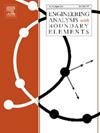A new isogeometric boundary element method to analyze two-dimensional potential and elasticity problems
IF 4.2
2区 工程技术
Q1 ENGINEERING, MULTIDISCIPLINARY
Engineering Analysis with Boundary Elements
Pub Date : 2024-10-07
DOI:10.1016/j.enganabound.2024.105986
引用次数: 0
Abstract
To reduce the impact of inhomogeneous boundary conditions on computational accuracy and the impact of redundant geometry refinement on computational efficiency in traditional isogeometric boundary element methods (IGABEM), a new IGABEM that introduces geometry-independent field approximation (GIFT) is proposed and applied to 2D potential and elasticity problems. Unlike in IGABEM, element nodes are located on the boundary, which facilitates the precise application of boundary conditions on nodes to improve computational accuracy. The constructed element features multiple inner nodes, allowing for the use of fewer elements in solving problems, which is beneficial for reducing redundancy and improving the computational efficiency of IGABEM. First, the geometrically precise BEM element is constructed using non-uniform rational B-splines (NURBS) to describe the geometry, while the field is approximated using B-spline interpolation and a transformation matrix. Second, the calculation formats of problems are derived by using parameter mapping. Third, the calculation of variables at boundary points is performed on the element through the relationship between variables. The subsequent processing is like the BEM. Finally, several numerical examples are discussed. It can be concluded from examples that the proposed method can obtain a high-precision solution and reduce computation costs.
分析二维势能和弹性问题的新等几何边界元方法
为了减少非均质边界条件对计算精度的影响以及冗余几何细化对传统等几何边界元方法(IGABEM)计算效率的影响,我们提出了一种引入几何无关场近似(GIFT)的新型等几何边界元方法,并将其应用于二维势能和弹性问题。与 IGABEM 不同的是,元素节点位于边界上,这有利于在节点上精确应用边界条件,从而提高计算精度。构建的元素具有多个内部节点,在解决问题时可以使用较少的元素,这有利于减少冗余和提高 IGABEM 的计算效率。首先,使用非均匀有理 B-样条曲线(NURBS)构建几何精确的 BEM 元素来描述几何,同时使用 B-样条插值和变换矩阵来近似场。其次,通过参数映射得出问题的计算格式。第三,通过变量之间的关系在元素上对边界点的变量进行计算。随后的处理过程与 BEM 类似。最后,讨论了几个数值示例。从实例中可以得出结论,所提出的方法可以获得高精度的解,并降低计算成本。
本文章由计算机程序翻译,如有差异,请以英文原文为准。
求助全文
约1分钟内获得全文
求助全文
来源期刊

Engineering Analysis with Boundary Elements
工程技术-工程:综合
CiteScore
5.50
自引率
18.20%
发文量
368
审稿时长
56 days
期刊介绍:
This journal is specifically dedicated to the dissemination of the latest developments of new engineering analysis techniques using boundary elements and other mesh reduction methods.
Boundary element (BEM) and mesh reduction methods (MRM) are very active areas of research with the techniques being applied to solve increasingly complex problems. The journal stresses the importance of these applications as well as their computational aspects, reliability and robustness.
The main criteria for publication will be the originality of the work being reported, its potential usefulness and applications of the methods to new fields.
In addition to regular issues, the journal publishes a series of special issues dealing with specific areas of current research.
The journal has, for many years, provided a channel of communication between academics and industrial researchers working in mesh reduction methods
Fields Covered:
• Boundary Element Methods (BEM)
• Mesh Reduction Methods (MRM)
• Meshless Methods
• Integral Equations
• Applications of BEM/MRM in Engineering
• Numerical Methods related to BEM/MRM
• Computational Techniques
• Combination of Different Methods
• Advanced Formulations.
 求助内容:
求助内容: 应助结果提醒方式:
应助结果提醒方式:


